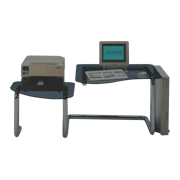"Only specialized technicians can make changes, even in response to small requests from departments using computers." -- Complaints like this became more frequent as the scope of computer use expanded inside companies. The ADPS (pronounced "adopusu") was announced in 1989 with a shocking catch phrase: the "program-less" computer. Its most important concept was end-user computing.
Features for business processing -- such as RDB access and billing -- were integrated into an interface anyone could use. At the core was the "PS" language which allowed anyone to simply describe their requests provided they understood the business task being done, even if they did not know programming.
Features of the PS language were:
- (a) Data operations in business processing were patterned, and this made description possible using simple instructions which were conceptually different from previous programs.
- (b) Functions for controlling interaction with the RDB were made independent, and a structure was devised where file control instruction information was embedded in internal records as part of the data.
In ordinary data processing tasks, for instance totaling accounts data by month, the user simply had to indicate what they wished to do. This eliminated the need for specialized knowledge of SQL and other computer topics.


